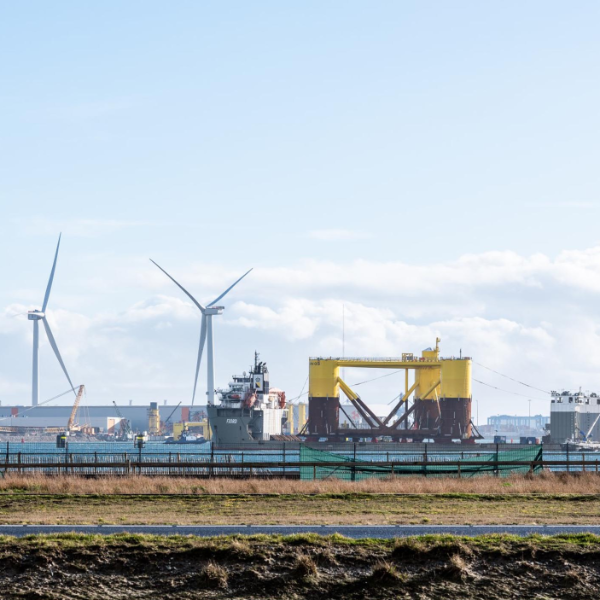Sif deep-sea quay:
Enabling offshore wind energy

Sif deep-sea quay:
In order to meet the increasing demand for offshore wind energy, the Port of Rotterdam Authority expanded the Sif deep-sea quay on the Maasvlakte. Witteveen+Bos produced the design and specifications for the extension of this quay, the strongest and deepest in the Netherlands. Project manager Peter Quist takes a look back.
Design and specifications within four months
‘The Sif quay is used for the production and supply of components for offshore wind farms. Large foundation elements and piles are loaded on board by jack-up vessels. These ships have legs which they extend to the port floor; they then push themselves upwards. This requires a high loading capacity of the quay. A retaining height of 30 metres, the heavy combi wall with anchoring MV piles, and a relief floor with pressure piles provide this. But the existing quay, completed in 2017, had become too small. We produced the design and contract documents for a new, 200-metre-long deep-sea quay. And we did it in the space of a few months: in February 2020, we were awarded the contract; in June, the specifications were ready for publication. Our collaboration partner, Movares, focused on the construction road, integrated safety, and the necessary permits. In December, construction started; one year later, the quay was completed. That is unprecedentedly fast.’
Sustainable ambition
‘The Sif deep-sea quay is the strongest and deepest in the Netherlands. The equipment needed to build a quay like that is extremely heavy. You have to work at the limits of what is possible. Also, a lot of material is needed, especially concrete and steel. Nevertheless, we set ourselves the goal of making the design as sustainable as possible – for example, by making the quay suitable for a future crane track. The pressure piles under the relief floor are vibro-piles, meaning we don’t leave behind any lost steel casing in the ground. That was the case with the existing quay. We also paid attention to sustainability in the specifications and tender, among other things by including the environmental costs of energy use as an assessment criterion for contractors. We created an optimal design in terms of material use and construction methods.’
BIM 3D model
‘The infrastructure in the wall is enormous. There are sensors in the quay, for example, that can register things like how the quay reacts to loads during both the construction and use phases. Also, pits and a large number of casing pipes have been installed in the concrete superstructure to accommodate future quayside power facilities. This allows ships to switch off their generators and reduces emissions. We put this huge puzzle together with the help of a BIM 3D model. The question we constantly asked ourselves was: Can it be done even smarter?’
Best kind of project
‘I’m very proud of the performance we achieved together, both in the design process and during construction. Thanks in part to regular and open communication with those involved, we were able to carry out this complex project in a short space of time. For me, projects like this are the best kind: the new Sif quay is technologically advanced and also essential for the increasing demand for renewable energy. Electric vehicles, heating houses with electricity, heat pumps: the demand for electricity is increasing enormously. This quay is an important step in making greater use of wind energy, which will allow us to better meet our energy needs. I hope that Witteveen+Bos will be able to contribute to more projects like this in the future.'
More information?
